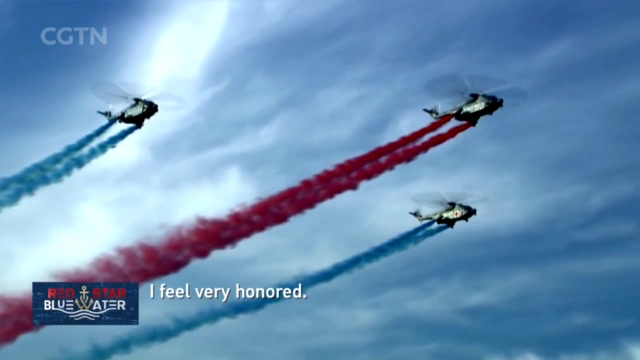
13:34, 22-Apr-2019
China's Naval Air Force: Z-9 formation will present at naval parade in Qingdao
Updated
13:30, 25-Apr-2019
04:54

And in today's special series "Red Star, Blue Water", we focus on the naval air force. CGTN correspondent Han Bin was given rare access to a regiment in the eastern Chinese port of Qingdao, which will take part in the 70th-anniversary parade. He spoke with pilots and technicians during rehearsals, and got a first-hand look at how this new branch is transforming the navy.
Before the pilot enters the cockpit, The ground crew have to finish their job.
LIN BINBIN FLIGHT ENGINEER "The work we do is the routine maintenance for the helicopter, taking care of every detail. If even one screw comes off, or if there's a leak in the pipe connection, it could be a great danger to the controls, as well as the take-off and landing. We are behind the scenes. What everyone usually sees is the pilot flying in the sky. But the flight can't happen without our silent efforts."
It's been ten years since Lin Binbin was assigned to this regiment. He says he has a special feeling towards the aircraft.
In my opinion, our helicopter is more like a sword, to conduct an accurate strike on the command of the ship.
Flight officer Liu Peng and his team are preparing for the big parade. While it's not combat, it's not without danger.
LIU PENG, FLIGHT OFFICER PLA NAVAL AVIATION "An outstanding pilot needs both physical strength, the foundation, as well as psychological. The formation is to see the overall effect. One aircraft doesn't represent overall ability. This requires each aircraft to be stable. Watch the lead aircraft and try to be stable."
Liu Peng has been flying Z-9 helicopters since 2005. He can see the rising role of naval aviation through increasingly diversified missions. The Z-9 is one of China's latest indigenous aircraft with advanced attack capabilities. The Navy has accelerated its modernization as required for offensive and defensive operations.
The key is to follow the lead aircraft, and then through the co-pilot and tactical commander get some data like the distance, altitude and speed.
With the navy going blue, and the expansion of the carrier fleets, its air weaponry is also progressing.
"Our aircraft is more like a light cavalry in the sky. It's highly flexible."
"Naval Aviation is mainly engaged in missions on the sea, accompanying ships on patrol, reconnaissance and escort. With the transformation and growth of the army, the training intensity is becoming much higher. Especially when the new pilots are assigned, their growth period has been seriously shortened. As our navy continues to sail farther, our ships are getting bigger and bigger. They can carry helicopters for operations. So we have more cooperation with other units."
HAN BIN NAVAL AVIATION REGIMENT, QINGDAO "Historically, Chinese Naval Aviation has been land-based. Now it covers maritime patrols, anti-submarine operations, and logistical support. And the aircraft carrier program has expanded its new dimension to missions farther offshore."
Participating in the anniversary parade is another sign this new branch is taking center stage in the Navy.
LIN BINBIN FLIGHT ENGINEER "Although we can't go to the review, our aircraft will fly smoothly through. This is the greatest encouragement to us."
LIU PENG, FLIGHT OFFICER PLA NAVAL AVIATION "Being an ordinary pilot of the Navy Air Force, who could be in the naval parade for the 70th anniversary, I feel very honored. We will present the very best to the people of the country and the world, with the new image of our naval aviation force."
If the sky is the limit, the navy's air force is determined to challenge it. Han Bin, CGTN, Qingdao.

SITEMAP
Copyright © 2018 CGTN. Beijing ICP prepared NO.16065310-3
Copyright © 2018 CGTN. Beijing ICP prepared NO.16065310-3